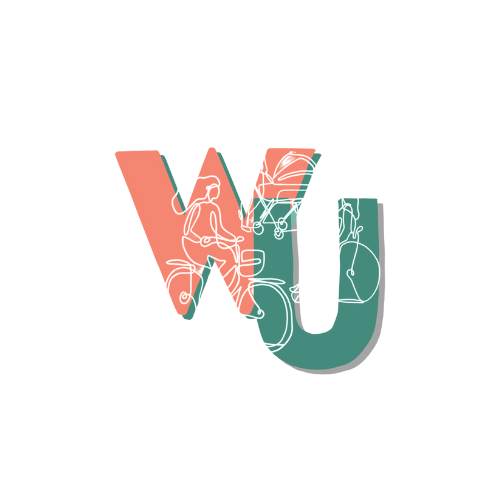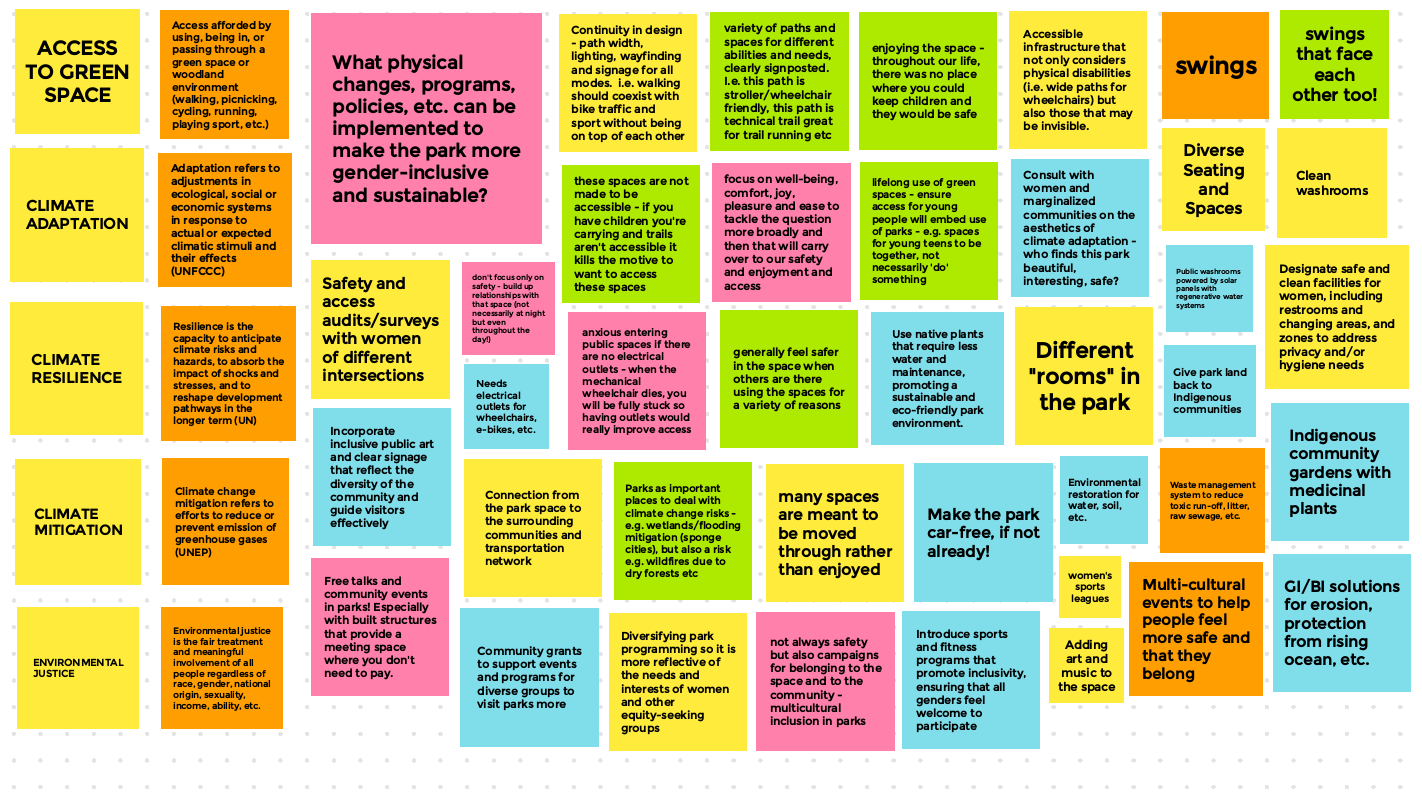Event Recap: Gender-Based Climate Adaptation at Point Pleasant Park
Halifax, Nova Scotia. Photo taken by Lilit Houlder.
On Thursday, August 24th, 2023, Women in Urbanism Canada (WIUC) hosted our first-ever public event and the first workshop in our three-part virtual series. This workshop “Gender-Based Climate Adaptation at Point Pleasant Park” focused on a Halifax-based park through a gender-equity and sustainability lens. The session featured WIUC board member, Ally Lord, as moderator, and two Halifax-based expert speakers, Delvina Bernard and Zamani Folade. This workshop was a sold-out event, with the full capacity of 75 registrants being reached days before the session! Thank you so much to everyone who registered and joined us. Here is a high-level summary of the session, some of the key takeaways, and the video recording. Audience
Our audience included guests from Alberta, British Columbia, Manitoba, Quebec, Nova Scotia, Ontario, and even outside of Canada! At the beginning of the session, the audience identified as being most familiar with the topic of sustainability, followed by gender equity and racial justice, with accessibility slightly trailing behind. We also asked our audience if they had ever been to Point Pleasant Park, with 80% of our audience selecting “no.” Accordingly, many folks were learning about this park for their first time from our Halifax-based hosts! Group photo of the workshop participants
Presentations
In Delvina Bernard’s presentation, she addressed 1. Political Issues vs. Technical Issues, 2. Consider unconscious bias in gender-based work, and 3. Advance two key messages. Key Message #1: Intersectionality-informed approaches to understanding the relationship between gender-inclusive public parks, climate change, and equity diversity inclusion accessibility.Key Message #2: European settlers came to Nova Scotia with a plan of how they would use and develop the lands. Women, children, Indigenous people, African Nova Scotians, persons with disabilities, newcomer immigrants, etc. have remained on the margins of park planning.
In Zamani Folade’s presentation, she discussed, 1. Achieving climate resilience through climate mitigation and adaptation, 2. Gender-based climate adaptation, and 3. The role of planners and architects in climate justice. Key Message: Planners and architects hold a lot of privilege in society - they design the built environment with which we interact daily. Planners and architects are responsible for designing buildings and communities that engage and serve all people.
Activities
Activity #1 focused on drawing connections between women and their use of public parks. Each breakout room was assigned a set of statistics, relating to economics, mobility, caregiving, gender-based violence, or demographics to answer the question “how may these statistics impact women’s use of public parks/spaces?” For economic statistics, some of the key impacts identified include:Lower-income housing has poor planning, resulting in higher urban density and often less access to green spacesWomen need to work more than men to reach comparable income levels, leading to more time allocated towards survival instead of leisure and healthAccess to public transit to parks either isn’t available or takes too long, leaving many parks to be designed around people with cars
For mobility statistics, some of the key impacts noted include:If a person is walking for transport, they are limited to parks close byTrip-chaining means that women are often carrying a heavy load with limited timeWaiting spaces for public transit in parks may feel unsafeUrban furniture, width of paths/sidewalks, and quality of trails can limit ability to travel with companions or the mobility of disabled persons
Inspired by Feminist City, a workshop participant referenced the importance of friendships for women in cities:“We kept each other safe, and even more, helped each other learn to take up space, to fight back, to be ourselves despite the constant reminders about how we were supposed to look or behave. My friends were my safety net, my city survival toolkit.” - Dr. Leslie KernFor caregiving statistics, some key impacts identified are:That women need spaces for children to play with easy and comfortable supervisionPublic spaces need to be close to other daily amenities, such as school, work, groceries, etc., or else women may not be able to access them oftenIf crosswalks, bus stops, and mobility infrastructure are not designed for all ages and abilities, families are unable to travel togetherLack of washrooms with running water limits the amount of time women can spend there with children
For gender-based violence, the group identified the following impacts:Women are generally carrying more stress due to hypervigilance while in public spacesPublic spaces are heavily dominated by men, due to programming, activities and designWomen are less likely to use the public spaces, especially if secluded or it is late at night
“You wouldn’t necessarily be able to articulate why you avoided different places (as a woman), you just do it”. - Workshop ParticipantFor demographic statistics relating to age, ability, and gender identity/sexuality, the key impacts include:Lack of accessible infrastructure limits access for those with disabilities to use public spaces, especially when it is not predictable what is thereLack of benches in parks gives no place for women to rest. Younger women can use blankets and sit on the ground, but women with disabilities or mobility challenges cannotWomen (and gender-diverse people) may not have sufficient access to washrooms, especially not gender-inclusive facilitiesLack of diversity of activities offered in parks by community groups (not always LGBTQ2S+ inclusive)
Building on the impacts considered in Activity #1, Activity #2 focused on developing solutions for Point Pleasant Park. Collectively, the group answered the question “what physical changes, programs, and/or policies could be implemented to make the park more gender-inclusive and sustainable?”. This question was answered with consideration for access to green space, mitigation, adaptation, resilience, and environmental justice. Image of the notetaking board during Activity 2, 2023
Some of the key solutions identified are:Conservation/Sustainability
Give park land back to Indigenous communities,Community gardens with medicinal plants, food, etc.Environmental restoration for water, soil, etc.On-site clean energy production through community co-op model,Use native plants that require less water and maintenance, promoting a sustainable and eco-friendly park environment,Parks as important places to deal with climate change risks - i.e., wetlands/flooding mitigation (sponge cities), but also a risk e.g. wildfires due to dry forests etc.
Infrastructure/Facilities
Accessible infrastructure that not only considers physical disabilities (i.e. wide paths for wheelchairs) but also disabilities that may be invisible,Swings! Swings that face each other, too!Diverse public seating and activity spaces (different “rooms” in the park)Designate safe and clean facilities for women, including restrooms and changing areas, and zones to address privacy and/or hygiene needs,Public washrooms powered by solar panels with regenerative water systems,Waste management system to reduce toxic run-off, litter, raw sewage, etc.Green infrastructure and blue infrastructure to slow erosion, protect from rising sea levels, etc.
Mobility
Safety and access audits/surveys with women of various intersectional identities,Needs electrical outlets for wheelchairs, e-bikes, etc.Connection from the park space to the surrounding communities and transportation network,Continuity in design - path width, lighting, wayfinding and signage for all modes, i.e., walking should co-exist with bike traffic and sport without being on top of each other,Variety of paths and spaces for different abilities and needs, clearly signposted, i.e., this path is stroller/wheelchair friendly, this path is a technical trail great for running, etc.
Events/Programming
Diversifying park programming so it is more reflective of the needs and interests of women and other equity-deserving groups,Multi-cultural events to help people feel more safe and that they belong,Community grants to support events and programs for diverse groups to visit parks more often,Free talks and community events in parks! Especially with built structures that provide a meeting space where you don't need to pay,Introduce sports and fitness programs that promote inclusivity, ensuring that all genders feel welcome to participate, i.e., women’s sports leagues,Campaigns for belonging to the space and to the community - multicultural inclusion in parks,
Enjoyment
Consult with women and marginalized communities on the aesthetics of climate adaptation - ask, who finds this park beautiful, interesting, safe?Lifelong use of green spaces - ensure access for young people will embed use of parks - i.e., spaces for young teens to be together, not necessarily to 'do' something,Focus on well-being, comfort, joy, pleasure and ease to tackle the question more broadly and then that will carry over to our safety and enjoyment and access.
Art
Adding art and music to the space,Incorporate inclusive public art and clear signage that reflect the diversity of the community and guide visitors effectively.
Conclusion
For those who were unable to attend, or those who would like to review their experience again in more detail, the recording is available here. We hope you will join us for our upcoming sessions, “Gender-Based Inclusion at St. John’s Park” and “Gender-Based Placemaking at Edworthy Park” in September and October 2023. Thank you to our speakers, our sponsors, and our participants for making this wonderful session possible! This workshop series is made possible with the generous support of the TD Park People Grant. 



